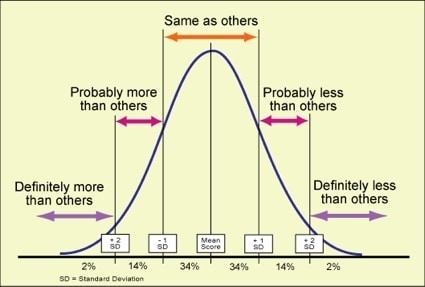We're Off the Bell Curve Here
One Size Fits All. Oh wait. Is Your Animal Average?
A reader writes,
I subscribe to your newsletter, bought your book on preventing heart worm and have learned so much. My St Poodle weights only 43 lbs., is 8 yrs old. She eats honest kitchen food. I can see and feel her spine and ribs. They are more prominent than they should be. I would like to put some weight on her. What can you suggest I feed her? She has been on grain free since a year old because she had ear infections and eye stains when on food with grains. That cleared after we eliminated grains.”
Another reader writes,
Factory-farmed poultry can be problematic for dogs.…my dog’s skin turned black and smelly. This condition resolved when I stopped feeding chicken.”
Another who saw me yesterday with a patient said,
He gets way more fleas than the other dogs in our house.”
I saw two dogs last week who’ve lived together for years with their people, and they were quite different, though eating the same good raw food, in the same household. Both had a vaccination as an adult to travel through Canada to relocate here in Texas. Nigel, the Aussie/Bulldog mix reacted a week later with a swollen, red inflamed muzzle, oozing fluid. Jazmine, the Rottweiler, had the same vaccination, on the same day, and 3-4 days later reacted with intermittent diarrhea.
Nigel has to be prompted to eat. Jazmine would eat hungrily at any opportunity.
What have you learned about your animals?
The somewhat maddening thing about biology is that its members are quite variable. You know the bell curve? It’s the curve with the big hump in the middle that tapers out to either end. In the middle are the average things, dogs, people, insects, etc. and out at either end are the extremes, high and low.
An appetite bell curve would have the anorexics at one end, those dogs or cats that need hand feeding, maybe stirring between bites and cooing to get them to eat, and the opposite end has the ravenous eaters, who’d eat a bar of soap if you didn’t watch them! And in the middle lie the average guys: you put the food out, they dig in, finish pretty quickly, and don’t think about food till it comes around the next time.
So, where are your animals on the bell curves of life? Some that might be useful include:
- Appetite, as above, including eating lots but being skinny
- Thirst (rarely drinks, even after exercise to frequenting the toilet, the pool, the tub after you shower)
- Ease of stool passage (one end: very difficult, infrequent, unless you add canned pumpkin, to the opposite, 5-6 stools a day and falling out unnoticed)
- Reactivity to stimuli (startles easily to anything new all the way to indifferent, hard to get his attention)
- Reactivity to foods (can only eat a very limited diet or all hell breaks loose: diarrhea with the slightest change, itchy skin with chicken, to the “cast iron stomach” where anything vaguely resembling food is just fine.
- Cold natured, can’t get warm enough vs wasted in the heat, loving the snow, or liking the middle ground (like me).
There are two points to this story:
1. You need to know the quirks and individuality of your animal. I’d suggest you write them down.
Why is this useful? Well, if you ever hire a veterinary homeopath to help your animal, we’ll want to know all this stuff and more. It’s why I posted this page on symptoms. Homeopathy really only works when we get the whole patient figured out, and match a remedy to that patient that can elicit a healing response.
2. You need to learn what works for your animal.
Where is your animal on the bell curve?
Feeding chicken causes smelly, dark skin but that goes away when you feed turkey?
He has to eat a lot to maintain weight?
If you buy a food for your dog or cat, there’ll often be a “recommended amount to feed” on the package. Guess who that’s speaking about on the bell curve? You got it: the guys in the middle, the average 40-60 lb dog or 10 lb cat. Are your pets in this group? Maybe, but you’ll have to watch and learn.
If you are feeding the recommended amount and your dog stays too skinny, start by adding 25-50% more to the food bowl, and see where that weight goes. Or, add enzymes, especially if you are feeding a kibble (you know not to feed your cat kibble, right?)
If the recommended amount on the box isn’t cutting it, you need to, literally:
Think outside the box!
This is going to be true in a lot of areas, especially if your goal is the raising of vital animals, the guys who shine, have a bounce in their step and will be around to live a long and joyful life with you.
I submit that if you just follow the party line and dutifully march in to Dr. WhiteCoat each year to do whatever is recommended, you’ll have a damaged animal in a relatively short time. Way too many vaccinations will come, for one thing. And food from Food, Inc. that will damage health as well. And flea poisons. And heartworm pesticides.
Here’s a recent example from my practice. A charming 17 year old cat came in because his owner was just not ready to start insulin for him, as recommended for his blossoming diabetes. Don was also being fed, at a “holistic” vet’s recommendation, a prescription diet from Hill’s, M/D, touted as glucose management food.
As I’d never heard of it, I quickly looked up the label and was floored! Label detectives, get out your magnifying glasses, this one is unbelievable.
I’ve copied the first 9 ingredients for your review:
Chicken By-Product Meal, Corn Gluten Meal, Pork Fat (preserved with mixed tocopherols and citric acid), Pork Protein Isolate, Powdered Cellulose, Brewers Rice, Whole Grain Corn, Dried Egg Product, Chicken Liver Flavor…
Here, in the name of glucose management, is corn gluten meal at #2, the sugariest possible ingredient is pet food. And number one is byproducts, which can include any number of toxic waste products from the killing floor. #4 in the list is likely sawdust (yum, good fiber, important for health!), and “brewers rice” is a spent byproduct of the brewing industry. Then More Corn! And a flavor that likely came from New Jersey’s chemical factories where organic chemistry runs wild to make addictive flavors of all manner.
As my head spun, I spun my iMac around to show Annette, who was as appalled as I, and we decided on the spot that Don was going to be offered some whole Cornish hens that very night. Last report, he was interested (after being a bit afraid at first — whoa, what’s that, Mom?).
So, yes, think outside the box. And the can, and the bag and the system. Learn all you can. You can listen to everything recommended to you by the whitecoats, but make up your mind once you’ve researched further. You rarely have to decide on the spot, unless your animal is bleeding and needs a transfusion to save her life.
Got some furry family members who don’t play by the bell curve rules? Tell us about them in the comments.






I have 2 chocolate labs who are actually related, but still different as night and day! Katie was laying out in the sun the day it was 106 degrees, while Connor was standing by the door going “are you all seriously going to sit out here in this heat?!?” Katie used to be an extremely picky eater, and I used to say Connor would eat rocks if I put them in his bowl, but since switching to a raw diet they are both moving more toward the middle of that bell curve. Very interesting stuff!
It is interesting, especially when relations are so different, isn’t it Heather?
Thanks for revealing the outrageous ingredients in this cat food. It is truly astonishing (and sad in my opinion), and as you know from our consultations I give my cats Rad Cat Turkey (suggesting for other cats with insulin issues).
I have four dogs, all of them are different, I can tell you all of their differences. And I treat, feed, excersise all differently.
Very interesting and important information here, Dr. Falconer. Several months ago my friend was beating herself up because she doesn’t take the doctor-recommended amount of insulin and called herself bad. Basically she was parroting her physician’s assessment of her behavior.
Not having any proof, but coming from my instinct, I told her that I felt she was taking the exact right amount of her insulin and that her intense 6-8 hour dance “marathons” she participates in every weekend were keeping her healthy. I see her and spend a lot of time with her and she is in amazing shape and is clear of mind.
I asked her how she thought they came up with the dosage they recommend and shared that I thought it might be a one-size-fits-all (maybe variations based upon weight and/or degree of the physical issue) and that perhaps she was the best judge of what she needed. How could a whitecoat tell her what is right for her! Who decides that these are the right doses to give people to begin with?
She is feeling great, she takes care to eat something often enough that she doesn’t wilt and she takes the amount of insulin her body needs, not what her physician says she needs. When she thought about it, you could see a lightbulb go on in her mind. She absolutely felt that she was listening to her body intelligence and giving it what it needs. Now she feels better about herself rather than taking on the doctor’s shaming behavior.
The reason I share this lengthy story is because I think it follows along the same lines as the subject of this post, only it’s a human story. Perhaps we should all think about NOT giving over our power to a whitecoat and doing what we feel is right for us. When we can do that, then we’ll be better able to observe our pets and and rely upon our own instinct and judgment to give them what the need.
Just some thoughts….
I’m glad you shared this; I agree with this approach as well. It’s what works … for people and for pets.
Hi Elle,
Thanks for this thoughtful share. I think the best way to handle chronic disease is team work — it’s very difficult to go it alone. Mistakes can be costly, and I tend to not trust even my own intuition solely, as we are always “under the influence” of our changing mind states.
Someone with diabetes (or cancer or AIDS or CFIDS) should seek out a trained professional that she feels she can work closely with, in addition to keeping a close watch on what works for her life, in terms of eating, exercise, etc. That professional in my mind is a homeopath, who works solely in homeopathy and treats a lot of chronic disease.
Then, real magic can happen.
first off, I have NO homeopathic vets any where near me. It’s pathetic. I’ve got a border collie mix, about 9 years old, and she’s itchy. I’ve tried long distance homeopathy with a great gal, but we can’t get a hold of it. I’ve never fed kibble with grain and have always done a lot of home cooking for my dogs. I’m currently trying a ‘yeast removal’ program and trying to ‘heal the gut’, although, I don’t know why her gut wouldn’t be ok? I’ve used digestive enzymes and probiotics. I don’t vaccinate, or use heartworm or flea preventative. I don’t use chemicals in my house or on my lawn. I’m about to scream and the poor dog is miserable. Any thoughts? Thinking of doing a Dr Dodd’s saliva test.
Have you tried a good quality fish oil. Fat and oil is so good for the brain and skin.
yes, they are on fish oil capsules….and Seacure and Seavive, a good probiotic and a good digestive enzyme.
Hi Janice,
There are, unfortunately, not nearly enough trained homeopathic vets available, but don’t let that stop you. Try another practitioner (listed on the AVH list, on my Recommended Resources page), and choose one who’s ideally certified and practices primarily homeopathy (the list breaks this down for you). I’ll be publishing an article in the next issue of Dogs Naturally Magazine about a cured case of itch, that emphasizes how important getting the whole patient figured out is.
While the itch drives you crazy, it’s the “rest of the dog” that will find the best remedy at any given point.
And it’s not easy. Managing the chronic patient takes a lot of experience. But these guys can be cured with professional help.
seriously Dr Falconer, there are NO qualified vets any where near me. It’s not practical to have a qualified vet that’s 200-500 miles from where you live. Indiana, as a rule, is ultra conservative. Even for myself, there are only 2 integrative medicine doctors in the Fort Wayne area, and they are booked (and over booked) solid for up to a year. And Fort Wayne is the 2nd largest city in Indiana! It’s awful!
There is 1 qualified (I think) vet in Indianapolis. I did call her office,….she’s booked out for months and it’s a 120 mile drive, one way for me.
Hi Janice,
You’ve recognized that there simply aren’t enough holistic vets to go around, and while that’s true, you still have options.
Most of my clients use me exclusively as their “primary physician.” On rare occasion, I’ll need to send a patient in for a lab workup, or even more rarely, a surgery. It’s quite possible you could work with someone by telephone appointments and use your local vets for the neutering and odd testing needs that come up. I do this for a number of long distance clients, and it works well. We have to get to know your animal intimately for homeopathy to work, so you have to be a watchful, descriptive owner, but most folks get the hang of it pretty quickly. See my Resources page for listings of homeopathic vets and see if you can’t find someone to work with. They’ll also be listed by geography, and who knows, maybe one or two who haven’t shown up in your Google searches to date.
Best of luck.
I did the Dr Dodds saliva test for my girl golden and have eliminated anything she is sensitive to and she has blossomed! I feed raw and dehydrated foods, canned sardines, coconut oil, fish oil from nordic naturals, bloom from Honest Kitchen, raw bones, and they rarely get the same protein for more than 4 days in a row.
After a walk or run, Gonzo will make a bee line to sit ditectly on top of the cold air floor vents, with the air blowing his golden locks. Its quite comical. While Fozzie is comfortable laying on the wooden floors. And most of the day, Gonzo is resting on the floor vent. Gonzo also prefers laying on the cooler marble floors in the bathroom at night, while Fozzie is fine laying on the wooden floors. Both are standard goldendoodles, and surprisingly Fozzie is the one with the longer, thicker, darker coat.